
From Singapore, Eileen and I took Ryan on a trip to West Malaysia before heading back to Sarawak. Nature watching was not our primary purpose, but our friends Chips and Shirleyour good friends Ng Chih Piew ("Chips") and his wife Shirley Lim did arrange a couple of outings for Ryan from Kuala Lumpur in the company of Terry Law, a local naturalist.

The first, on December 26, visited the grounds of FRIM, the Forest Research Institute of Malaysia, on the edge of the city. The ponds and forest edge on the FRIM grounds are good places for a young naturalist to investigate.
We start small, with ants negotiating their way around a flower head.
Also on the small side: a fly, stretching out one wing in some sort of display.
We'll keep with insects for a while, but move on to a few larger ones. Palm Darts (Telicota sp.) are a group of common but (for me at least) difficult-to-identify skippers. These are separate individuals; perhaps separate species, for all I know.
Also in the common-but-difficult category are the grass yellows (Eurema sp.). There are nine species in Malaysia. This one appears to be a Chocolate Grass Yellow (Eurema sari sodalis), based on the shape of the brown patch at the tip of the forewing.
And here is the unfortunately-named Nigger (Orsotriaenia medus). Can't someone come up with an alternate English name for this butterfly?
I'm easily distracted by the local odonates (dragonflies and damselflies, for the non-initiated). I think this damselfly is a female Violet Sprite (Archibasis viola), but then again, maybe it isn't.
Neurothemis fluctuans, the Common Parasol, is very common indeed in Peninsular Malaysia. This is an adult male.
Also on the small side: a fly, stretching out one wing in some sort of display.
We'll keep with insects for a while, but move on to a few larger ones. Palm Darts (Telicota sp.) are a group of common but (for me at least) difficult-to-identify skippers. These are separate individuals; perhaps separate species, for all I know.
Also in the common-but-difficult category are the grass yellows (Eurema sp.). There are nine species in Malaysia. This one appears to be a Chocolate Grass Yellow (Eurema sari sodalis), based on the shape of the brown patch at the tip of the forewing.
And here is the unfortunately-named Nigger (Orsotriaenia medus). Can't someone come up with an alternate English name for this butterfly?
I'm easily distracted by the local odonates (dragonflies and damselflies, for the non-initiated). I think this damselfly is a female Violet Sprite (Archibasis viola), but then again, maybe it isn't.
Neurothemis fluctuans, the Common Parasol, is very common indeed in Peninsular Malaysia. This is an adult male.
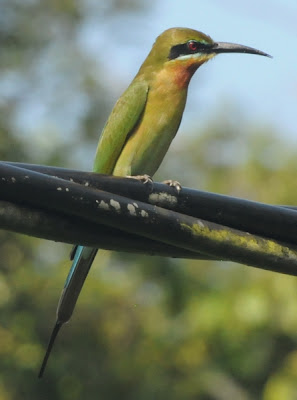

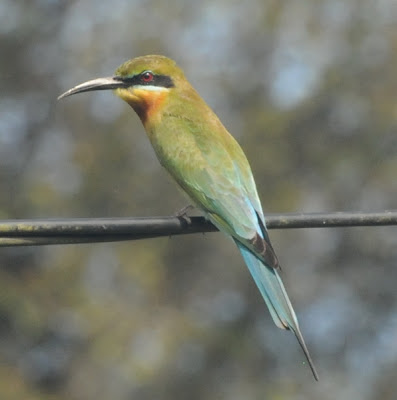
There are obvious and colourful birds - Blue-tailed Bee-Eaters (Merops philippinus) perched gracefully on wires or hawking overhead for prey (including, no doubt, some of the insects we have been looking at)...

..and a Black-naped Oriole (Oriolus chinensis) peeking out from behind the fronds of a palm.
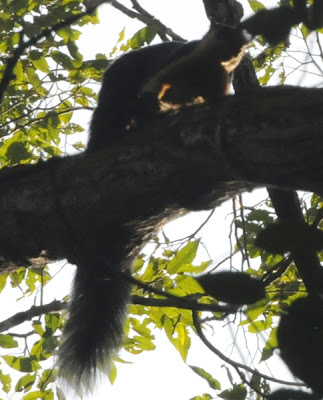
Overhead we spot a Black Giant Squirrel (Ratufa bicolor) scampering along a tree limb, silhouetted againt the sky…
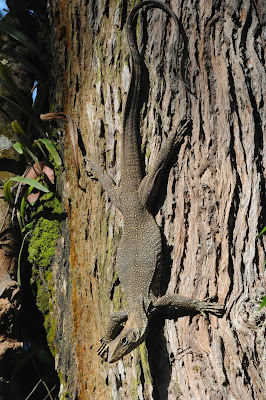
…and, picking its way down a trunk, a young Water Monitor (Varanus salvator).
From the FRIM grounds we moved on to the environs of a nearby orang asli community (orang asli is a generic term for the indigenous people of Peninsular Malaysia).
We followed a road through second-growth scrub dotted with rubber trees scarred with the tappers' cuts.
The road paralleled a small, sandy-bottomed stream. This little fish is almost certainly a member of the Cyprinidae, and is probably a barb of some sort - but that's as far as I can go.
By now we were in the heat of the day, when insect-watching usually takes over from birding as a strolling naturalist's activity of choice. From the FRIM grounds we moved on to the environs of a nearby orang asli community (orang asli is a generic term for the indigenous people of Peninsular Malaysia).
We followed a road through second-growth scrub dotted with rubber trees scarred with the tappers' cuts.
The road paralleled a small, sandy-bottomed stream. This little fish is almost certainly a member of the Cyprinidae, and is probably a barb of some sort - but that's as far as I can go.
I'm not sure what this colourful little caterpillar is going to grow up to be, but its bright markings and apparent disinterest in hiding suggest it has some toxic defences at hand. Best to leave it alone!
Compare this Neurothemis fluctuans with the one I showed you earlier. The extent of dark on the wings is pretty variable in this species, and in this individual it barely reaches the inner edge of the pterostigma (the little red bar on the leading edge of each wing).
This is an immature male, his wing patches pale amber instead of russet brown. In this species - but not in some other members of the genus - the female's wings are largely clear.
More common dragonflies: the ubiquitous Orthetrum sabina…
And two red-bodied species (there are several others, just to make things more difficult for dragonfly-identifiers): Orthetrum testaceum (above) and the psychedelically-glowing Trithemis aurora (below).
Butterflies along the road edge included one of the more identifiable pierids, the Chocolate Albatross (Appias lyncida). I'm still not are why these butterflies are called albatrosses, unless the black edging on the wings reminded someone of the wing patterns on the birds (for albatrosses with feathers, see my trip to Kaikoura in New Zealand).
The Common Lime (Papilio demoleus) is one of the more ubiquitous and successful Malaysian swallowtails. It gets its name not from its colour (or, presumably, flavour) but because its caterpillars are citrus eaters. The species ranges from the Persian Gulf to Australia and the Pacific. It is a recent arrival in Borneo, where it is now common, and an introduced pest in the Caribbean. There is a good article on the species in Wikipedia.
More butterflies, all nymphalids: a Malay Cruiser (Vindula dejone) (top), a Malay Viscount (Tanaecia pelea) (middle), and two photos of a rather tattered Peacock Pansy (Junonia almana) (bottom).
While all these little critters are quite capable of keeping me happy, their effect on a boy just shy of five (as Ryan was at the time) may be less exciting. For real small-boy thrills, though, nothing beats a snake. When a villager (who realised what we were about) walked up to us with this creature draped over a stick, it was the high point of the day.
His find was an Oriental Whip Snake (Ahaetulla prasina), coloured mustard-yellow rather than the almost shocking green of many individuals. For Ryan any snake is exciting (though as this one is mildly venomous I didn't let him get too close), but for me tho species is especially fascinating as a remarkable example of convergent evolution.
It's a ringer for a number of unrelated vine snakes (Oxybelis, etc) from Central and South America. Like them it is a tree-dweller, with a long, thin body capable of extending itself into space for a remarkable distance and a peculiar pointed snout. Pet fanciers, who have unfortunately taken to both the Asian and American snakes, frequently mix them up (as a quick internet search will tell you).
So both Ryan and his Grandpa had something to be excited about! The snake was released, by the way (and I hope it stayed that way), and the day ended, I presume, happily for all.



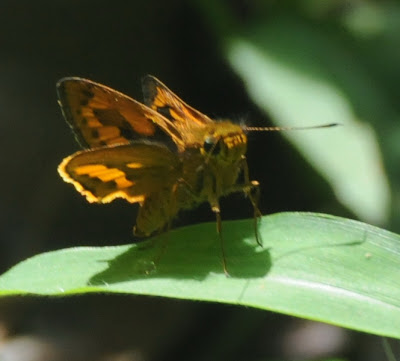

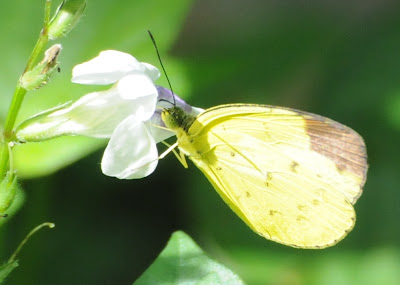
























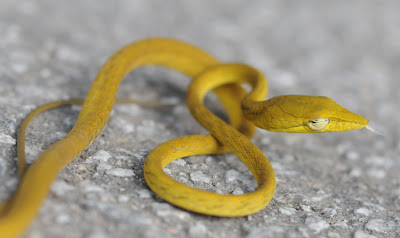

thanks for sharing your knowledge and resource on the Blog. Terry
ReplyDelete